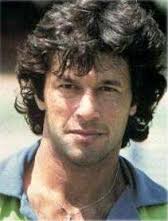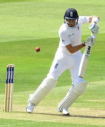Imran Khan’s Test match career against West Indies
Gareth Bland |
Of the quartet of great all-rounders from the seventies and eighties, Imran Khan Niazi enjoyed the company of the West Indies in five Test series, beginning in the Caribbean summer of 1976/77. By the time he had completed his final series against the West Indies of Desmond Haynes in 1990/91, he was in his cricketing dotage. By then in his thirty-ninth year, Imran had attained a level of preeminence and achieved such universal respect that he had transcended cricket itself. Prior to the rise of Tendulkar, Imran was the sub-continent’s first truly global cricketing superstar. A Pathan, from the north of his country, Imran claimed that “the status of a man is measured by the status of his enemies”. Along with Botham, Hadlee and Kapil Dev, Imran’s least forgiving enemy during those fourteen years came in the form of West Indies. His performances against them – some of the contests numbering among the most epic battles of the 1980s – define Imran’s status as one of the greatest all-round cricketers ever to play the game.
When Imran appeared in his first Test series against West Indies in 1976/77 he was still a relative greenhorn, despite having been around the national side since 1971 when he was just 18 years old. At the age of 24, he was, in the words of Geoff Boycott, “a fast bowler who didn’t know it”. In Pakistan’s preceding series Down Under against the Australians, he had come to prominence during the Sydney Test with a match winning, dozen wicket haul. With match figures of 12-165, Imran had set up Pakistan’s maiden Test victory in Australia and levelled an absorbing three match series.
In the West Indies, hard on the heels of the Australian tour, Pakistan continued to develop as a team and almost achieved parity with the home side. A close 2-1 series defeat saw Imran’s first series of encounters with three quarters of the original pace quartet. With Holding ruled out of the rubber through injury, West Indies were still able to field Garner, Roberts and Croft throughout the five Test series. His confrontations with Andy Roberts, in particular, left an indelible – and almost physical – mark on the young all-rounder from Lahore.
In a one day international in Berbice, Guyana, Imran shaped aggressively to face Roberts. Unable to fully comprehend why the great Antiguan was hitting so many batsmen, Imran soon found out for himself. As he explains:
“Roberts came on, and I hit him back over his head for four. I was prepared for a retaliatory bouncer, and I was rather surprised to see him amble up to the crease rather than run in hard. This put me off my guard, and I didn’t expect to see him bowl a bouncer. Of course, he did – and I didn’t see the ball until it was about two feet away from my face. In a reflex action I used the bat to protect my face, and the pace of the ball was such that it flew out of the ground for six. I was quite pleased with the shot, and told everyone that it was intentional. In fact I was petrified at the time, and if the ball had hit me it might have ended my career”
The impact of the series on Imran can be measured in far more than mere statistics. It encouraged him to don the helmet as soon as they came into use, and it also shaped his entire approach to playing the West Indians in future. Asian batsmen, he felt, had been unusually jumpy and ill at ease against high pace. In future, as captain of the side, he would place great emphasis on packing his batting order with men who could fight and brave it out against the quick men. With the bat in that 1976/77 series Imran totalled 215 at 21.50. Invariably batting lower down the order than he would later in his career, usually at number eight, Imran still scored a vital 47 in the third Test in Guyana. With the ball, though, he continued to excel as he had done in Australia. A more than respectable series haul of 25 wickets at 31.60 showed that the young all-rounder was beginning to find his feet at international level at last.
Imran next encountered West Indies in 1980/81 in a home series during the ill-fated first tenure of Javed Miandad’s captaincy. Although West Indies took the series 1-0, Imran can look back with fond memories to the scoring of his maiden Test hundred, achieved on his 28th birthday. Coming in at 95-5 after Javed’s dismissal, Imran’s 123, on his home ground, took Pakistan to an eventual 369. Although Holding and Roberts missed the Test series, a West Indian attack of Sylvester Clarke, Croft, Garner and Marshall was a suitably intimidating one and proved a daunting enough quartet for the Pakistani batsmen to deal with.
In the four Tests Imran scored 204 runs at an average of 29.14, figures dominated by his Lahore century in the opening game. With the ball, the ungainly action of yore – an unfortunate amalgam of Lance Cairns, Ronnie Irani and Mike Procter, which won few marks for artistic merit – had been replaced by the smooth, arcing run up and classical delivery stride that we have come to associate with the second half of Imran’s career. His ten wickets in the four Tests at an average of 23.60 hardly do justice to the transformation.
When the rivalry reconvened in the Pakistani summer of 1986/87 much had changed. The vagaries of the international calender meant that a full six years had passed without the two teams meeting in a Test series. In my debut CW feature I argued that the great missing Test series of the 1980s was a full five match series between these two sides in early 1983. It just had to be that year. 1983, after all, meant a fully rested West Indies machine, about to embark on the rout of all opposition in the year ahead. Perhaps equally significantly, that very year saw Imran Khan, captain and fast bowling all-rounder, at his absolute career zenith. In the preceding Tests series with India he had been almost unplayable, snaring 40 Indian Wickets at a cost of just 13.95. After the shin injury which reduced him to a batting captain in the 1983 World Cup, he would never be as fast again.
In 1986/87, however, Imran was 34 and, though still sharp, reliant on brains more than sheer brawn; the absolute cutting edge of his pace having been nullified by age and that injury. West Indies, meanwhile, had witnessed the retirements of Holding, Garner, Gomes and Lloyd since their last meeting. Marshall was bowling spearhead by that time and had been joined by Walsh, Gray and Patterson. In a genuinely enthralling series, whose only downfall was that it lasted just three Tests, Pakistan and West Indies shared the honours 1-1.
Imran was fractionally shaded into second spot in the batting averages by Javed, although a mean of 28.75 per innings was a fair reflection of the hostilities encountered out in the middle by the Pakistani batsmen. No batsmen on either side made a century, as Imran, Wasim Akram and Abdul Qadir made life equally difficult for Viv Richards’ men. As a bowler Imran utilised all his craft, claiming 18 West Indian scalps for 11.05 at a strike rate of 35.4. It had been a heavyweight encounter and undoubtedly one of the greatest of the decade, despite its truncated nature.
In the first half of the decade there had been visible daylight between West Indies and the rest. In the second half of the 1980s that gap narrowed, due largely to Imran shaping a Pakistani team that was able to compete with West Indies where no other team could. Whereas David Gower’s England lost 10 Test Matches out of 10 between 1984 and 1985/86, and Kim Hughes’ woes throughout 1984 saw him resign in tears, Imran’s team was able to go toe to toe. In 1987/88, in the Caribbean where it all began for Imran and the Windies 11 years earlier, the 35 year old all-rounder was coaxed out of retirement to captain his country once more. Answering the sirens’ call yet again, where he had yearned instead to take off and fly his kite, hunt and shoot in the Pakistani frontier, he was set once more to take on Viv Richards’ team in a three Test series.
In a three match series which was, if anything, possibly even more dramatic than the previous one between the two teams 18 months earlier, Pakistan’s captain once again stepped up to play a vital role in the drawn series. In the first Test in Guyana Imran was named man of the match for his 11 wicket haul. Steaming in on the first day, he took 7-80 in strength sapping heat during which he donned a headband that would not have looked out of place on Mark Knopfler at Live Aid.
In West Indies second innings the Pakistani skipper chipped in with 4-41 to follow his team’s first innings 435. Eventually getting home by nine wickets, Pakistan had inflicted the first home defeat on West Indies in a decade. West Indies finally came back to draw the series in the final, gripping encounter in Barbados as a result of the partnership between Dujon and Winston Benjamin which steered them home by two wickets. In a series which proved that there was nothing between the two teams, Javed Miandad observed “It probably represents some of the best cricket that’s ever been played anywhere”.
Despite his advancing years Imran was still the side’s bowling spearhead, reflected in his series figures of 23 wickets at 18.08. Two five wicket hauls and a ten wicket match performance in Guyana meant that he achieved a strike rate of 33.08. In his 36th year he put into practice everything he had learned in the game. He was less effective with the bat in early 1988, as it was left to Javed Miandad to prove his mettle and stand head and shoulders above his team-mates. Javed’s two centuries left him with a series average of 56.40, while his captain, Imran, scored 90 at 22.50.
The final episode in the rivalry came in 1990/91 by which time Imran was 38. Less influential with the ball this time – he did not bowl at all in the first two Test matches – he was content instead to leave the attack to Wasim and Waqar. Once again there was nothing between the teams as honours were shared 1-1. Imran, opposed by Desmond Haynes this time in Richards’ absence, narrowly missed out on the top batting slot, making 151 runs at 50.33. With the ball, his four wickets in the final Test came at a cost of 13.50.
Imran Khan appeared in five Test series against West indies, spanning a fourteen year period. His first series, in 1977 in the Caribbean, was the last great Test Series before the Packer schism reshaped the game. When the two teams next faced each other in 1980/81 he was a quite different proposition. By then 28 and a world-class performer, his bowling had been refined and remodelled thanks to the help of Packer colleagues like John Snow and Mike Procter. By 1986/87, and then in 1987/88, he was the leader of a team which was a genuine challenger for the finest cricket team in the world. This was not some accident, as he himself had enjoyed considerable input into the shaping of that team.
Imran’s Test career spanned 22 years. In the final 10 years he averaged 50 with the willow and 19 with the ball. His performances with both bat and ball against West Indies are testimony to a man who improved with age and who also rose to the challenge presented by the sternest opposition. With the ball Imran claimed 80 West Indian wickets at 21.18, compared with his overall rate of 362 wickets at 22.18. Those West Indian victims came at a strike rate of 43.6 and at an economy rate of 2.91 per over. Incredibly, Imran’s West Indian striking rate is a full 10 deliveries fewer than his overall Test career rate of 53.7.
As a batsman Imran maximised his talents to such an extent that he was eventually worthy of his place in the side as a batsman alone. That said, his batting mean against the teams of Lloyd, Richards and finally Haynes is a full 10 runs lower than his overall career average. An average of 27.67 in 18 Tests against West Indies is hardly disastrous in such a fearsomely competitive era, particularly for a man who would invariably bat at number seven for much of that time. In addition to that birthday century made back in November 1980, Imran also contributed three half centuries.
Statistics only tell so much of the story, however. The real measure of Imran Khan’s performance against West Indies is that, in the middle 1980s, he led a young team against one of the greatest ever assembled and achieved parity. Time and again he answered his country’s call and came up with the goods. When his team needed a performance from him in those two incredibly tight series in 1986/87, and in 1987/88, he came up with match winning performances and led by example. In Faisalabad in 1986/87 and then again in Guyana in 1987/88, he bowled his team to match winning situations.
As a batsman, his maiden Test hundred in Lahore against Croft, Marshall, Garner and Clarke rallied his side when the entire top order had been dismissed for just 95. In 1986/87 in Faisalabad on the first morning of the series, Imran was struck on the shoulder by a rising ball from Marshall as Pakistan reeled at 37/5. Although in acute pain with a stiff and swollen shoulder, Imran knew he could not leave the field. When Salim Malik had his arm broken at the other end shortly after the Pakistan skipper redoubled his efforts and was last man out for 61, his team having managed 159. It was just this kind of example that was so important to his young side in such tight situations.
He was on the losing side in his first two series in 1976/77 and then again in 1980/81 but, once captain, Pakistan did not lose a series with West Indies during the rest of his career. Ultimately it is this strength of leadership, augmented by his all-round playing capabilities, which puts Imran Khan into a different category than his three great contemporaries.





Its a good read and very detail oriented.Superb
Comment by CricketHuddle | 12:00am BST 11 August 2014
Dennis Lillee, Malcolm Marshall and Imran Khan are without doubt, the greatest fast bowlers of the 80’s. They played with and against the strongest batting and bowling brigades ever.
Comment by Rudy Rodricks | 7:31am BST 9 July 2016
He truly was one the few greatest bowlers the world cricket has seen particularly when in his prime from late seventies till 1982 when the injury strucj him and reduced the venom in his pace though he continued to b a match winning bowler right till west indies series of 1988 before age caught on him reducing him to a part time bowler. As batsman too he had gr8 capability which promoted him from tail to no. 3 postion and with improvrovement in batting postion his average too kept on increasing and he averaged at more than 50 in his last 50 tests out of total tally of 88. The story of odis is almost similar but because he played nearly 50% of his odi matches in the twilight of his career agewise (above 35), the bowling statistics are not as gr8 as should ve been. A very dependable batsman who wud perform under pressure and the crunch moments, his overall batting averages of nearly 38 in test cricket and 33 in odis are testimony to his batting prowess – a batsman he could play defensive as well as agressive cricket as per demands of the time. Finally one of greatest captains who indpired not only his teammates but also generations of cricketers.
Comment by A Manan | 10:40am GMT 21 November 2021